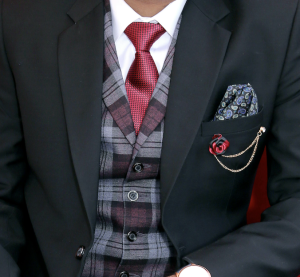For many men, buying a suit is a rare occasion and is often tied to a big life moment like an interview, wedding, funeral, or an important meeting. But whether you wear a suit daily or just a few times a year, investing in the right one makes a lasting impression. The difference between looking average and looking exceptional often comes down to a few smart choices. If you need assistance picking out your next suit, check out the Indiana Personal Stylist advice below!
Suit Selection Tips from Your Indiana Personal Stylist
Get the Fit Right
Fit is king when it comes to suits. Even a high-end designer suit will look sloppy if it doesn’t fit properly. The shoulders should hug your frame without pulling or puckering. The jacket should taper slightly at the waist, and the sleeves should show about a quarter inch of your shirt cuff. Trousers should sit at your natural waist and break just slightly over your shoes. If you’re buying off-the-rack, don’t expect a perfect fit. A good tailor can make magic with minor alterations. Expect to invest in tailoring—it’s worth it.
Understand the Different Suit Types
The three main types of suits include off-the-rack, made-to-measure, and bespoke.
- Off-the-rack: These suits are sold in standard sizes. They’re the most accessible and affordable, but they often require tailoring for a proper fit.
- Made-to-measure: This option uses a standard pattern that’s adjusted to your measurements. It offers a better fit than off-the-rack and more style choices.
- Bespoke: The top-tier option, bespoke suits are made from scratch using your exact measurements and preferences. They are the most expensive, but also the most personalized and luxurious.

Photo by Deepak Verma
Fabric and Color Matter
Wool is the most versatile and widely used suit fabric. It’s breathable, durable, and appropriate for most seasons. Super 100s to 120s wool is a solid middle ground in terms of quality and comfort. Avoid overly shiny or thin fabrics—they can look inexpensive.
For color, navy and charcoal are the safest choices. They work for both business and social settings and pair well with a variety of shirts and ties. Black suits, while formal, can be limiting unless you attend many black-tie events.
Watch the Details
The small details of a suit can elevate or cheapen the look. Check the stitching on lapels and buttons. Functional sleeve buttons, also called “surgeon’s cuffs,” are a sign of quality craftsmanship. Pay attention to lapel style as well. A notch lapel is classic and versatile, while a peak lapel adds a bolder, more formal edge. Two-button jackets are a standard choice for most men.
Don’t Forget the Shoes and Shirt
A suit is only as strong as its supporting pieces. A crisp white or pale blue dress shirt and classic leather oxfords or derbies will complete the look. Always match your belt to your shoes, and make sure everything is clean and polished.
Receive Professional Indiana Personal Stylist Guidance
Buying a suit doesn’t have to be intimidating. Focus on fit, fabric, and craftsmanship—and enlist a good tailor. Done right, a well-fitted suit is one of the most powerful style tools a man can own.




